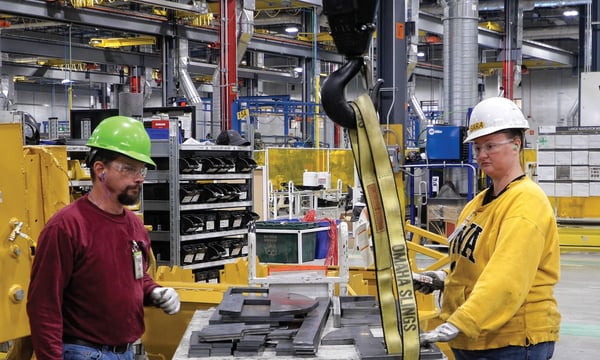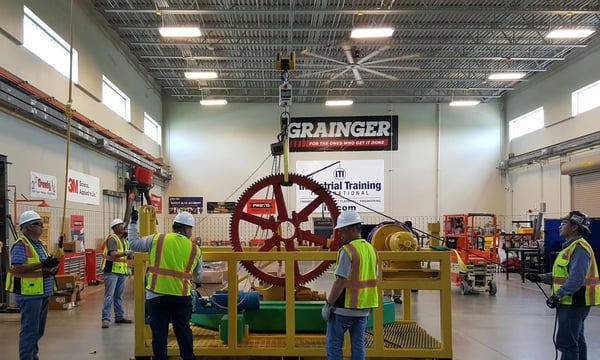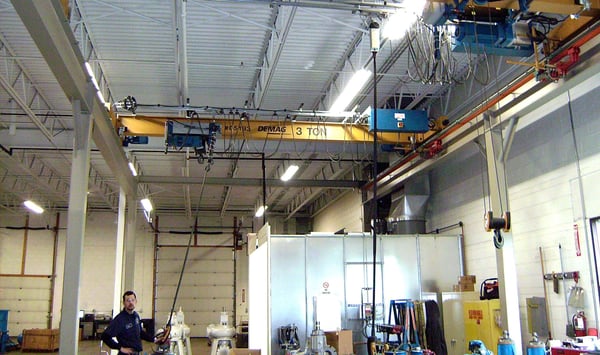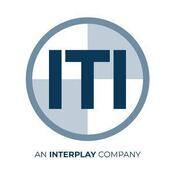You’re interested in getting started as an overhead crane operator but you’re not sure where to even begin. You’re in luck – Introducing ITI’s Ultimate Guide to Overhead Crane Training! Let’s first get started with the basics.
What is an overhead crane?
An overhead crane is a machine, or piece of equipment, that allows you to lift and move heavy materials from one location to another in a precise manner.

There are three basic types of overhead cranes:
- Gantry Crane: A gantry crane is a type of overhead crane with a single or double girder configuration supported by freestanding legs that move on wheels or along a track or rail system.

- Jib Crane: Jib cranes are shaped like an upside-down L. They are stationed in one space via a support beam or attached to a building.

- Bridge Crane: Bridge cranes are mounted on either side of a building and form a “bridge” above the work floor.

How are overhead cranes typically used?
Overhead cranes are regularly utilized to move heavy loads in factories, warehouses, and other industrial settings. They're often precision configured and designed to fit a specific form of loading application. Think automobile manufacturers, ship building facilities, and storage yards where items are regularly loaded and unloaded from trucks, rail cars and barges.

What are an overhead crane operator's responsibilities?
It’s important to note that while OSHA regulations do not spell out overhead crane training requirements, the American Society of Mechanical Engineers does indeed do so via the B30 Committee and the ASME B30. 2 Overhead and Gantry Cranes standard.
The charter of the ASME B30 Standards Committee on Safety Standards for Cableways, Cranes, Derricks, Hoists, Hooks, Jacks, and Slings is to develop, maintain, and interpret safety codes and standards covering the construction, installation, operation, inspection, testing, maintenance and use of cranes and other lifting and material movement related equipment.
Every few years, the B30 Committee reviews and updates existing standards as a result of:
- Technological advances
- Newly collected data
- Evolving environmental and industry needs
Before, During, and After the Lift - ASME B30.2
When lifting and moving a load, there are three phases of the lift, each of which are addressed in the ASME B30.2 Overhead and Gantry Cranes standard:
1. Before the lift2. During the lift
3. After the lift
Here we provide a glimpse into elements the stringent standard as it applies to the three phases of a lift.
Note: For the full list of crane operator responsibilities, please refer to Section 2-3.3.4 of the ASME B30.2 Overhead and Gantry Cranes standard available for purchase here via the ITI Bookstore.
Before the Lift, ASME B30.2 states that crane operators shall:
- Read and be familiar with the applicable provisions of crane equipment safety standards and the instructions listed in manual(s) provided with the equipment
- Be familiar with controls, instructions, and warnings located on the lifting equipment
- Not energize the main switch (crane disconnect) if a warning sign, lock, or tag is on the device until the sign, lock, or tag is removed by the person who placed it on the device or by a designated person
- Not remove a warning sign, lock, or tag that is on any switch that controls power to the crane, such as, but not limited to, the crane disconnect, motion disconnect, or runway disconnect, if the sign, lock, or tag was placed on the device by another person
- Place all controllers in the off position before closing the main line disconnect device
- Verify that no worker is on or adjacent to the crane before closing the main switch (crane disconnect)
- Not remove or obscure the warning or safety labels, plates, or tags furnished on the lifting equipment
- Be familiar with and understand hand signals

Additional Responsibilities
In addition to the responsibilities listed above, ASME B30.2 outlines the following tasks that crane operators shall do before executing an overhead lift:
- Verify that the hook, bridge, and trolley travel in the same direction as shown on the controls
- Verify that the hoist rope is free from kinks or twists and is not wrapped around the load
- Verify that the load, sling, or lifting device (when not reeved into the hoist ropes) is seated in the bowl of the hook
- Verify that the hook latch (when provided) is closed and not supporting any part of the load
- Verify that the rope is seated in the drum grooves and in the sheave(s) grooves if there is or has been a slack rope condition
- Activate the warning device, when a device is furnished
During the Lift, ASME B30.2 states that crane operators shall:
- Respond to all signals from a lift director or designated signal person.
- Verify the weight of the load without using a load-limiting device
- Make the lift only if the load is within the working load limit of the crane, hoist, and the components used in rigging.
- Minimize swinging of the load, and avoid sudden acceleration and deceleration of the load.
- Verify that the load and rigging are free to move and will clear all obstructions

After the lift, ASME B30.2 states that crane operators shall:
- Lift the load block and attachments above the highest movable obstruction under the crane when the crane is not in use
- Properly secure an outdoor overhead or gantry crane when the crane is shut down
- Open the crane main line disconnect device and the magnet disconnect switch (when applicable) before leaving the crane cab
- Place the controllers in the off position before leaving the controls of the crane
- Shut off the power to pendant-operated cranes before leaving area
Believe it or not, this above list is not comprehensive, hence the need training. For the full list of crane operator responsibilities, please refer to Section 2-3.3.4 of the ASME B30.2 Overhead and Gantry Cranes standard available for purchase here via the ITI Bookstore.
Are you ready to get started on your overhead crane operator journey?
The ASME B30.2 standard Overhead and Gantry Cranes, section 2-3.1. 2 states that training must be specific to the equipment and task, or application, at hand. That’s where we come in! We have designed multiple overhead crane operator courses which are applicable to those at various points in their careers.

The ITI 1-day Overhead Crane Operator Course is designed to instruct operators in the proper operating techniques and pre-operational inspection of overhead lifting devices which include bridge, gantry, monorail, fixed hoist, and jib wall mounts. Interactive, problem-solving classroom workshops are followed by hands-on activities. A written exam and hands-on evaluation will be administered.
This 4-hour, online overhead training course gives equipment operators a solid foundation in health and safety standards, preventative maintenance, and the proper procedures for safely operating overhead cranes. Delivered through multimedia presentations and interactive discussions, course content is reinforced through operator workbooks and supplementary handouts. Upon successful completion of this online course, a certificate of completion will be recorded and accessible for download and printing on the individual learner record.
Training with ITI
Did you know that you can train with us online, in-person at one of our Training Centers or your location, and even virtually via the ITI VR Crane Simulator (sneak peek below)?
Not sure which option is best for you? Contact us today, and we'll help get you set up with the optimal solution.
About ITI
Industrial Training International (ITI) is a global leader in the design and delivery of learning solutions for organizations conducting crane, rigging, and load handling activities. Founded in 1986, the company originally specialized in instructor-led training, field services, and consulting. ITI has since grown to also produce live online, and on-demand courses delivered via the ITI Learning Hub and has been recognized with numerous industry association awards for its groundbreaking virtual reality crane simulator solution. For more information about ITI, visit iti.com.






COMMENTS